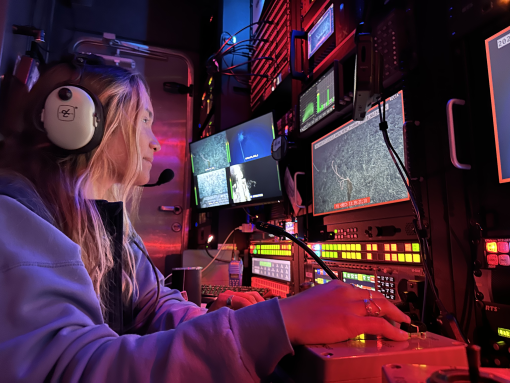Video Engineers manage the video feeds from the remotely operated vehicles (ROVs) underwater and cameras around the ship. While exploring, pristine video is the critical data deliverable to science teams allowing them to analyze the seafloor and review discoveries after the expedition. Video engineers ensure video recordings meet rigorous broadcast and scientific standards. They image items of interest by controlling the ROV camera’s zoom, focus, color, and iris. Although the Hercules pilots fly the ROV, the video engineer is the eyes of the operation.
Video engineers monitor the 36 cameras used in E/V Nautilus’ exploration model. There are 12 cameras on the two ROVs and 24 cameras around the ship. These cameras feed 28 monitors on the vessel as well as three web streams. Engineers also control all audio communications and ensure appropriate audio levels.
Video engineers choose which cameras are broadcast during operations to meet science goals and to provide the best storytelling perspective for viewers on www.NautilusLive.org. They also configure the intercom system to ensure different stations around the ship can communicate with each other and inside the control van. A normal expedition sails with three video engineers including one Lead Video Engineer who oversees and trains the team. On most expeditions, one of the video engineers on the team is a Video Systems Engineering Intern, frequently experiencing their first expedition at sea.

Career Pathways
The Lead Video Engineer typically has many years of experience in broadcast video operations at sea and on land. Within the Corps of Exploration, video engineers have training, degrees, and certifications in many fields including wildlife camera operation, computer science, broadcast technology, satellite engineering, video production, or graphic design. Many video engineers begin their work on Nautilus as a Video Engineering Intern in the Science & Engineering Internship Program as a community college, undergraduate, graduate student, or early career professional studying video production.








